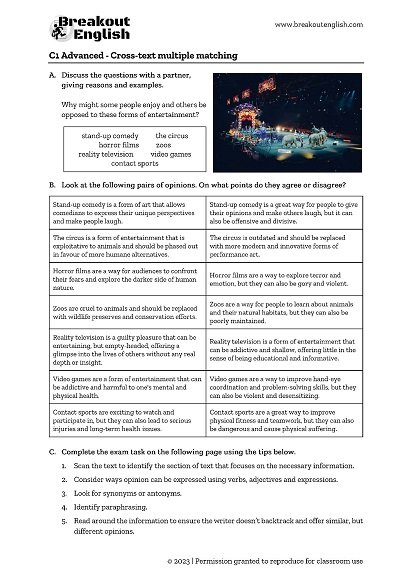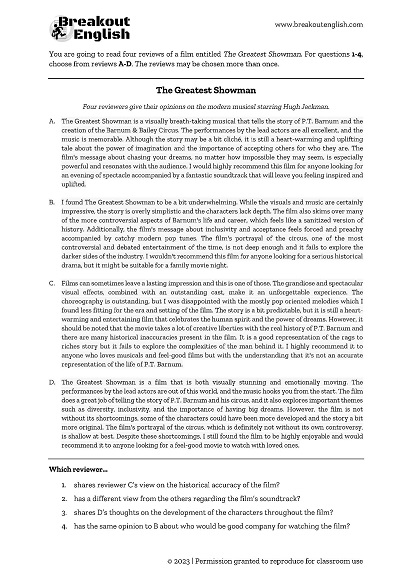When Cambridge updated the CAE exam in 2015, they included a new task type called cross-text multiple matching, which became the new Reading and Use of English Part 6 for the updated exam. This is a reading task with only 4 questions, but a surprising amount of text to wade through in order to answer them. If you’re not careful, CAE Reading part 6 can take up quite a bit of time, while also being worth less points than the rest of the exam. So how can we save time and improve our results for this task? With the activities below, we focus on some simple techniques to tackle the cross-text multiple matching with a worksheet about a film called The Greatest Showman.

Contents
What is cross-text multiple matching?
In this task you are given 4 texts which discuss the same topic. Often they are reviews of films, books or other entertainment. The key is that they contain similar, but different opinions on their topic. These opinions are not always immediately clear due to a wide range of language and expressions being used to express them. The questions focus on the similarities and differences in opinions. For example, maybe reviewer A and B share an opinion which reviewers C and D disagree with (or don’t mention at all).
Cross-text multiple matching is a curious reading task because it doesn’t exist in any other Cambridge exam. This task makes the reading content of the exam even longer than previous iterations, but not a huge amount of extra time is allowed. That’s where many exam candidates trip up because if you’re not careful, you end up reading the task over and over again.
CAE reading tips – Part 6
- Scan the text to identify the section of text that focuses on the necessary information.
- Scanning a text involves searching for words or phrases that are connected to the question. Once you have identified the section of text related to the question, focus on this and only this section. Do the same for each text and keep track of each writer’s opinion. If you try to read every text in detail, you will end up reading them four times each, taking way too long.
- Consider ways opinion can be expressed using verbs, adjectives and expressions.
- A writer will almost never be explicit with their opinion. Instead, they will express themselves using a variety of language that has either positive or negative connotations.
- Look for synonyms or antonyms.
- The people who design the exam aren’t going to make it easy for you. Instead of repeating words between texts, they will intentionally use synonyms to challenge you. This is where your C1 level vocabulary knowledge becomes especially important!
- Identify paraphrasing.
- Similar to the use of vocabulary, writers will construct phrases in different ways. One text may have a long explanation of their opinion while another expresses it in a few words.
- Read around the information to ensure the writer doesn’t backtrack and offer similar, but different opinions.
- Be careful of distractions! Cambridge love to include false opinions that are quickly contradicted with the true opinion. This happens in Reading just as much as it does in Listening, so watch out!
Materials
These materials focus on developing the skills to take advantage of the CAE reading tips above. The reading texts focus on opinions of a musical starring Hugh Jackman entitled The Greatest Showman. This musical was chosen based on its range of positive and negative opinions regarding the music and portrayal of history. You can use the materials to open up a debate on the positive and negative of many forms of entertainment.
If you’re using it in class, follow up with a personalised task where students brainstorm entertainment which they like and dislike. Then, tell them to think of reasons why someone might not share their opinions. This could be written or spoken then shared with other groups of students.
Download




